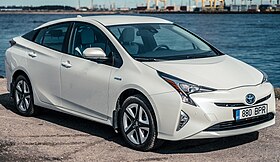| Toyota Prius | |
|---|---|
 | |
| Overview | |
| Manufacturer | Toyota |
| Production | December 1997 – present |
| Model years | 2001–present (US) |
| Body and chassis | |
| Class |
|
| Body style | |
| Layout | |
| 1997 | XW10 |
|---|---|
| 1998–2002 | |
| 2003 | XW20 |
| 2004–2008 | |
| 2009 | XW30 |
| 2010 | |
| 2011 | Prius V |
| Prius C | |
| 2012 | Plug-in XW30 |
| 2013–2014 | |
| 2015 | XW50 |
| 2016 | Plug-in XW50 |
| 2017–2021 | |
| 2022 | XW60 |
| 2023 | Plug-in XW60 |
The Toyota Prius (/ˈpriːəs/ PREE-əss) (Japanese: トヨタ・プリウス, Hepburn: Toyota Puriusu) is a compact/small family liftback (supermini/subcompact sedan until 2003) produced by Toyota. The Prius has a hybrid drivetrain, combined with an internal combustion engine and an electric motor. Initially offered as a four-door sedan, it has been produced only as a five-door liftback since 2003.
The Prius was developed by Toyota to be the "car for the 21st century";[1][2] it was the first mass-produced hybrid vehicle,[3] first going on sale in Japan in 1997 at all four Toyota Japan dealership chains,[3] and subsequently introduced worldwide in 2000.[4]
In 2011, Toyota expanded the Prius family to include the Prius v, an MPV, and the Prius c, a subcompact hatchback. The production version of the Prius plug-in hybrid was released in 2012. The second generation of the plug-in variant, the Prius Prime, was released in the U.S. in November 2016.[5] The Prius family totaled global cumulative sales of 6.1 million units in January 2017, representing 61% of the 10 million hybrids sold worldwide by Toyota since 1997.[6] Toyota sells the Prius in over 90 markets, with Japan and the United States being its largest markets.[7]
- ^ Blog, Toyota (11 December 2012). "15 years of the Toyota Prius". Toyota UK Magazine. Retrieved 29 August 2023.
- ^ "Secret story of the first Prius: New century, new car". Nikkei Asia. Retrieved 29 August 2023.
- ^ a b "History of the Toyota Prius". UK: Toyota. 10 February 2015. Retrieved 28 September 2018.
- ^ "Worldwide sales of Toyota Motor hybrids top 4M units; Prius family accounts for almost 72%". Green Car Congress. 22 May 2012. Retrieved 22 May 2012.
- ^ Cite error: The named reference
1stPriusPrimewas invoked but never defined (see the help page). - ^ Cite error: The named reference
TMC10miHEVswas invoked but never defined (see the help page). - ^ Cite error: The named reference
TMC9miHEVswas invoked but never defined (see the help page).